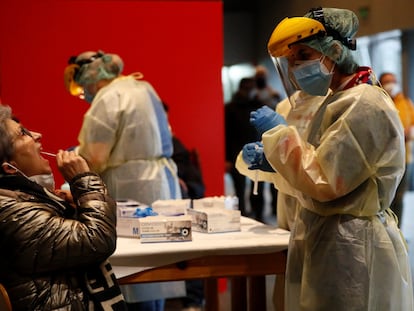Up to 40% of patients included in Spain’s coronavirus figures are actually admitted to hospital for other illnesses
The number of people being treated ‘with the virus’ instead of ‘because of Covid-19′ has risen sharply due to the spread of omicron and the protection offered by vaccines

Hospital occupation during the ongoing sixth wave of the coronavirus in Spain exceeded the maximum levels seen during the two previous spikes two weeks ago, according to the data supplied each weekday by the central Health Ministry and that is based on information sent from the country’s regions. The more than 17,000 patients currently in hospitals and who are carrying the virus are well in excess of the 10,500 seen during the fourth and fifth waves.
The heads of these healthcare centers, however, warn that any comparison should be made with caution. The reason for this is the highly contagious nature of the omicron variant, and the fact that most people who are vaccinated only present very mild symptoms or are asymptomatic. This has caused a spike in the percentage of patients who, despite having been included in the official statistics after testing positive via routine PCR tests, are in fact being treated for other illnesses.
“Just a few months ago there were very few of these patients,” explains Virginia Fraile, from the Spanish Society of Intensive, Critical and Coronary Unit Medicine (Semicyuc). “But recently they have grown a great deal as a consequence of the major increase in the registered incidence among the general population.”
EL PAÍS has questioned the regions as well as a dozen hospitals and specialists. While the majority responded by saying that they did not have precise information, the data collected show that between 25 and 40% of hospitalized patients are in this situation.
Julio Mayol, medical director at the Hospital Clínico in Madrid, explains that of the nearly 100 patients who tested positive when admitted, “two-thirds are suffering from Covid and a third are being treated for other reasons, although the virus may be related.” In the Hospital del Mar in Barcelona, 60% of cases are being treated for severe Covid while the other 40% for different pathologies.
Jesús Rodríguez Baño, head of infectious diseases at the Hospital Virgen de la Macarena in Seville, puts this percentage at 25%. Santiago Moreno, who holds the same position at the Ramón y Cajal Hospital in Madrid, calculates that “approximately 30% of cases are admitted with the virus but do not develop Covid.”
Spain is not supplying data on a national level that differentiate between the so-called hospitalizations “with the virus” and “because of the virus.” The only region that has offered any such figures is Madrid, via the deputy health chief Antonio Zapatero. “Forty percent of the patients who are admitted in Madrid with a positive PCR test are not coming in because of Covid,” he said last Tuesday.
Forty percent of the patients who are admitted in Madrid with a positive PCR test are not coming in because of CovidMadrid deputy health chief Antonio Zapatero
These percentages are similar to those offered by countries that are breaking down the data according to the two types of patients. The English healthcare system, for example, has supplied the figures from January 4. Then, of the 13,045 patients who were admitted with the virus, 8,200 were primarily diagnosed with Covid-19. This means that 37% of patients had a more serious illness. This percentage, what’s more, is growing fast, given that just 11 days earlier, on December 24, the figure was 32%.
The same distortion of the data that is caused by counting any positive result as a Covid case, independently of the reason for hospital admission, is happening with intensive care unit (ICU) admissions and with deaths. In the latter case, there is no data that allows for an estimation for the percentage of reported deaths that, in reality, are due to other causes, explains a spokesperson from the Health Ministry.
Virginia Fraile details how, with the current explosion of cases, there has been a rise in the number of “patients who are admitted with a heart attack, a stroke, other infections or even falls or traffic accidents,” and who end up swelling the official pandemic data when in reality “they are not being treated for Covid nor do they need supplemental oxygen due to the virus, but they are isolated to avoid infecting other patients and healthcare staff.”
The specialist adds that in some cases it is more difficult to rule out the virus having contributed to the poor health of a patient. “In the case of a heart attack, for example, the majority are asymptomatic and the virus does not cause them any problems, but we know that in a small percentage of people the virus is related to serious coronary issues.”
Julio Mayol believes that with the “incomplete knowledge of the virus that we have, associating only other pathologies to the clinical picture and excluding SARS-CoV-2 is something that cannot be ascertained apart from clearly evident cases, such as an accident or someone who you know has been infected inside the hospital.” He adds that “in cases where there are emergency room admissions with symptoms that could have various causes, such as heart conditions, respiratory insufficiency or mesenteric ischemia [decreased blood supply to the support structures in the abdomen], it is not possible to rule out the virus as a contributing factor or trigger.”
Re-evaluate the situation
Jesús Rodríguez Baño believes that the important thing is coordination between different specialists. “If the infection does not cause symptoms or they are very mild, the patient is treated by the corresponding specialist according to the reason for admission,” he explains. “This is the norm, but if the symptoms get worse it is important that we re-evaluate the situation together to see if it is a good idea to change the main diagnosis and the treatment,” he adds.
The Health Ministry and the regions agreed at the start of the pandemic to share data that can be compared and that allows for the monitoring of the health crisis. Despite this, the responses offered by the regions do not always coincide. For example, territories such as Andalusia, the Basque Country, Navarre and Murcia do not distinguish between patients admitted “due to the virus” or “with the virus” in the information they send to the ministry. While La Rioja and Extremadura, for example, say that they only include hospitalizations of patients “that require assistance due to Covid” in their daily figures.
Tu suscripción se está usando en otro dispositivo
¿Quieres añadir otro usuario a tu suscripción?
Si continúas leyendo en este dispositivo, no se podrá leer en el otro.
FlechaTu suscripción se está usando en otro dispositivo y solo puedes acceder a EL PAÍS desde un dispositivo a la vez.
Si quieres compartir tu cuenta, cambia tu suscripción a la modalidad Premium, así podrás añadir otro usuario. Cada uno accederá con su propia cuenta de email, lo que os permitirá personalizar vuestra experiencia en EL PAÍS.
¿Tienes una suscripción de empresa? Accede aquí para contratar más cuentas.
En el caso de no saber quién está usando tu cuenta, te recomendamos cambiar tu contraseña aquí.
Si decides continuar compartiendo tu cuenta, este mensaje se mostrará en tu dispositivo y en el de la otra persona que está usando tu cuenta de forma indefinida, afectando a tu experiencia de lectura. Puedes consultar aquí los términos y condiciones de la suscripción digital.
More information
Últimas noticias
Maduro pleads not guilty before the federal court in New York: ‘I am still the president of Venezuela’
A new test can detect Alzheimer’s from a finger prick
UN team enters Sudanese city of El Fasher after paramilitary massacre: ‘It’s like a ghost town’
A recipe for resistance: Indigenous peoples politicize their struggles from the kitchen
Most viewed
- Gilles Lipovetsky: ‘If you want to live better and fall in love, take Prozac, don’t look to philosophy’
- Alain Aspect, Nobel laureate in physics: ‘Einstein was so smart that he would have had to recognize quantum entanglement’
- Alvin Hellerstein, a 92-year-old judge appointed by Bill Clinton, to preside over Maduro’s trial in New York
- Why oil has been at the center of Venezuela-US conflicts for decades
- Maduro’s downfall puts China’s relationship with Venezuela to the test










































